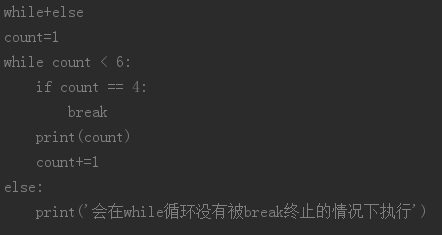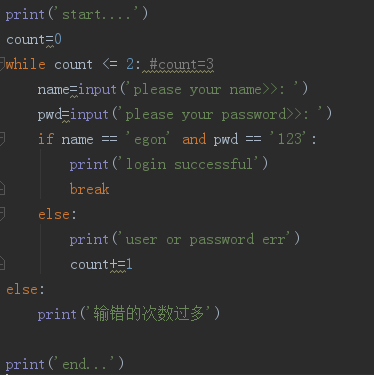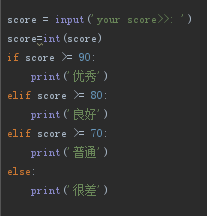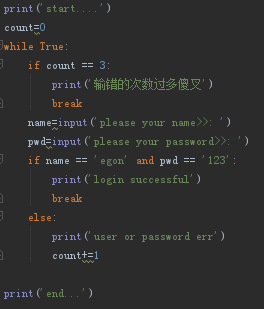一、if
1 什么是if判断
判断一个条件如果成立则做...不成立则做....
2 为何要有if判断
让计算机能够像人一样具有判断的能力
3、如何使用if判断
(1)if 条件1:
code1
code2
.....
(2)if 条件1:
code1
code2
.....
else
code1
code2
.....
(3)if 条件1:
if 条件2:
code1
code2
code3
code4
(4)if 条件1:
code1
elif 条件2:
code2
elif 条件3:
code3
elif 条件4:
code4
二、while
1. 什么是循环
循环指的是一个重复做某件事的过程
2. 为何要有循环
为了让计算机能够像人一样重复做某件事
3. 如何用循环
while循环的语法:while循环又称为条件循环,循环的次数取决于条件
while 条件:
code1
code2
4、如何结束while循环
(1)操作while循环条件让其结束
例一
print('start..')
tag=True
while tag:
name=input('please your name>>: ')
pwd=input('please your password>>: ')
if name=='egon' and pwd=='123':
print('login successful')
tag=False
else:
print('user or password err')
print(end..)
例二
count=1
while count < 6:
print(count)
count+=1
(2)break强行终止本层循环
例一
print('start..')
while True:
name=input('please your name>>: ')
pwd=input('please your password>>: ')
if name=='egon' and pwd=='123':
print('login successful')
break
else:
print('user or password err')
print(end..)
例二
count=1
while True
if count > 5:
break
print(count)
count+=1
(3)假设如何设置输错三次就退出
方式一:
print('start...')
count=0
while count <=2:
name=input('please your name>>: ')
pwd=input('please your name>>: ')
if name =='egon' and pwd =='123':
print('login successful')
break
else:
print('user or password err')
count+=1
print('end..')
方式二
5、continue代表结束本次循环,直接进入下一次
ps:不能将continue作为循环体最后一步执行的代码
6、while+else

输错三次则退出之while+else的应用

7、while循环的嵌套
name_of_db='egon' pwd_of_db='123' print('start....') count=0 while count <= 2: #count=3 name=input('please your name>>: ') pwd=input('please your password>>: ') if name == name_of_db and pwd == pwd_of_db: print('login successful') while True: print(""" 1 浏览商品 2 添加购物车 3 支付 4 退出 """) choice=input('请输入你的操作: ') #choice='1' if choice == '1': print('开始浏览商品....') elif choice == '2': print('正在添加购物车....') elif choice == '3': print('正在支付....') elif choice == '4': break break else: print('user or password err') count+=1 else: print('输错的次数过多') print('end...')
8、tag控制所有的while循环
name_of_db='egon' pwd_of_db='123' tag=True print('start....') count=0 while tag: if count == 3: print('尝试次数过多') break name=input('please your name>>: ') pwd=input('please your password>>: ') if name == name_of_db and pwd == pwd_of_db: print('login successful') while tag: print(""" 1 浏览商品 2 添加购物车 3 支付 4 退出 """) choice=input('请输入你的操作: ') #choice='1' if choice == '1': print('开始浏览商品....') elif choice == '2': print('正在添加购物车....') elif choice == '3': print('正在支付....') elif choice == '4': tag=False else: print('user or password err') count+=1 print('end...')
三、for
for循环主要用于循环取值
student=['egon','虎老师','lxxdsb','alexdsb','wupeiqisb']
1、如果不用for取值,用while
i=0 while i < len(student): print(student[i]) i+=1
2、用for取值列表
for item in student: print(item)
3、用for取值字符串
for item in 'hello': print(item)
4、用for取值字典
dic={'x':444,'y':333,'z':555}
for k in dic:
print(k,dic[k])
5、用for取值range
for i in range(1,10,3): print(i)
range(1,10,3)指1到10之间去的整数不包括10,3是指间隔,输出结果是1,4,7




